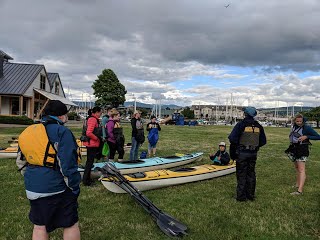By Eleanor Hines, North Sound Baykeeper and Lead Scientist
A few weeks into Orca Month 2018 (also known as “June” to many of you), we got some sad news – we lost one of our iconic Southern Resident Orcas, bringing their population down to just 75 – the fewest orcas alive in the Salish Sea since the early 1980s. And then we saw the haunting display of love and loss when a mother orca carried her dead newborn calf on a “tour of grief” that lasted more than two weeks.
It all seems disheartening. But there are many ways our little length of shoreline in Bellingham Bay can play a key role in restoring our orca population, even though orcas are rarely seen here. To start a conversation about it, Moondance Sea Kayak Adventures and RE Sources took eight interested paddlers out on a kayak tour of Bellingham’s waterfront to celebrate Orca Month. We launched our tandem kayaks from Zuanich Park into the choppy water for a close-up look at seven spots along the waterfront — including some sites the public hasn’t had access to for decades.
Industrial activities in the 1900s were followed by a legacy of pollutants left in the ground — like mercury, nickel, petroleum byproducts, and more — made most of the waterfront area off-limits to the public for about 100 years. The shoreline has also been physically altered by armoring, dredging up sediment, and filling in parts of the natural shoreline to build on. These changes make the waterfront hazardous to young Chinook salmon, which need clean, protected nearshore habitat to grow and make it to the open ocean. And Chinook salmon make up 80% of our resident orcas’ food source.
The decline of these salmon is a huge reason orca numbers have dropped and aren’t rising; Puget Sound Chinook are hovering around 10% of their historical numbers. Combined, the resident orca pods eat roughly half a million salmon per year. To give some perspective, the entire Skagit River can feed our orcas for about one month out of the year with its current salmon runs. Juvenile Nooksack Chinook, who rely on the habitat in Bellingham Bay, also face considerably smaller numbers of salmon returning. The spring Nooksack Chinook runs are listed as “Threatened” under the US Endangered Species Act.
It’s impossible to restore healthy orca populations without talking about helping salmon, and it’s impossible to help salmon without making Bellingham Bay hospitable to their young.
 From Pollution to Public Parks
From Pollution to Public Parks
We were lucky enough to be one of the first-ever groups leading a visit to sites that demonstrate a successful and collaborative cleanup effort. Waypoint Park – home of the 400,000 pound, eye-catching acid ball – is a brand-new example of what the City of Bellingham and others hope can become of some of our old industrial sites. The public can access the area for the first time since pre-industrial times, now free of legacy pollutants left behind from the pulp and tissue mill operations at Georgia Pacific West. It’s been carefully constructed with rocks and a tiny pocket beach, creating perfect habitat for young Chinook, fresh out of their riverine hatching grounds to grow accustomed to the salty sea where they’ll become adults. In fact, the city added pocket beach to the design of Waypoint Park after getting input from the public. The City, the Port, the Department of Ecology, and others are also removing shoreline armoring, to prevent good habitat from eroding away.
All these teams turning swaths of polluted sediment into parks and salmon habitat is something unique and worth appreciating. Several of those kayaking with us had recently come to Bellingham from all over the place: North Carolina, Utah, a recently graduated college student and her aunt. One person hailed from Chicago, and he noted how toxic sites around his hometown haven’t been cleaned up, let alone considered for public use. Seeing a community actively trying to clean up – and provide access to the cleaned-up spaces – felt impressive and new.
Making sure the redevelopment suits our community’s needs, as well as those of the salmon that humans and orcas rely on, is a big priority. The good news is, like with Waypoint Park, we can build a thriving waterfront with interconnected parks and business without sacrificing plentiful habitat for orcas’ most critical food source. The City and Port of Bellingham have a dream of making a trail connecting some of these sites, incorporating parks and valuable habitat, making it a draw for people from downtown to the waterfront.
As your North Sound Baykeeper, it feels good to be on the forefront of reconnecting people with natural spaces around their home. We aim to have even more people come paddle on the water with us in the future. This is YOUR waterfront, and I hope you’ll join me to make it healthier for all.
What can YOU do?
Ecology will be releasing several public comment periods on other cleanup sites, such as South State Street Manufactured Gas Plant at Boulevard Park and the I&J Waterway, so stay tuned for more tours and ways to participate in the public process of cleaning up and redeveloping our waterfront. Sign up for our e-news to get updates or check our Watchdogging Permits page for updates on public comment periods.

 From Pollution to Public Parks
From Pollution to Public Parks